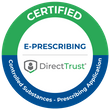Transforming Healthcare with Bidirectional Lab Interfaces
Seamless Communication. Streamlined Workflow.
What is a bidirectional lab?
Simply put, a bidirectional lab interface allows information to flow from the physician to the lab and back again, in real-time.
This bidirectional exchange allows real-time communication, reduces manual processes, minimizes errors, and enhances the overall workflow and coordination between the laboratory and healthcare providers.

Connected to all Major Labs
Our bidirectional lab management feature paves the way for swift and effective data transfer between all of healthcare’s divisions, ranging from private doctor practices, hospitals, labs, up to state databases. Immediate access to patient information, test orders, and results helps clinical staff and laboratory technicians provide better patient care. As an EHR/PM platform, eMedicalPractice provides a comprehensive solution that includes the patient chart as an integral component. Within our platform, the patient chart serves as a centralized repository for all patient-related information, including lab orders and results.
Viewing and Ordering
Easily create and send your lab orders and review the results directly from the patient EHR, eliminating the need to access separate systems or external portals. By integrating the lab ordering and result viewing functionality within the patient chart, eMed ensures a cohesive and efficient workflow.
For test results, a color coding system is applied, which serves to emphasize any abnormalities present. This intuitive feature assists healthcare professionals swiftly identify potential health issues and easily spot trends in laboratory data. With a visual representation of test results, the efficiency of result analysis is enhanced and facilitates effective comparison between different sets of data.
Contacting Patients
Waiting for test results often causes patients anxiety. Our real-time lab connection ensures timely results, reducing patient wait times.
Follow-up Needed: Patients will receive a notification letting them know that their results are ready for review, and then asked to schedule an in office follow-up appointment.
When an in-office visit isn’t necessary, patients will be sent an automated message notifying that lab results are in, and available to access in the patient portal.

